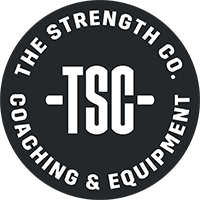Training Tips for the New Dad
By Connor King, SSC
It has been 6 months since my wife and I welcomed our first child into the world. As with most expecting parents, we received plenty of advice from friends, family, and complete strangers.
The consensus of all solicited and unsolicited advice was clear, things were going to change. Sure, sure… major life change. The loss of time, finances and sleep. I get it. But will this impact my training?!
While this article is mainly written for the new dad or parent, the principles can be applied to anyone who finds themselves short on time and are looking for the most effective use of time in the gym.
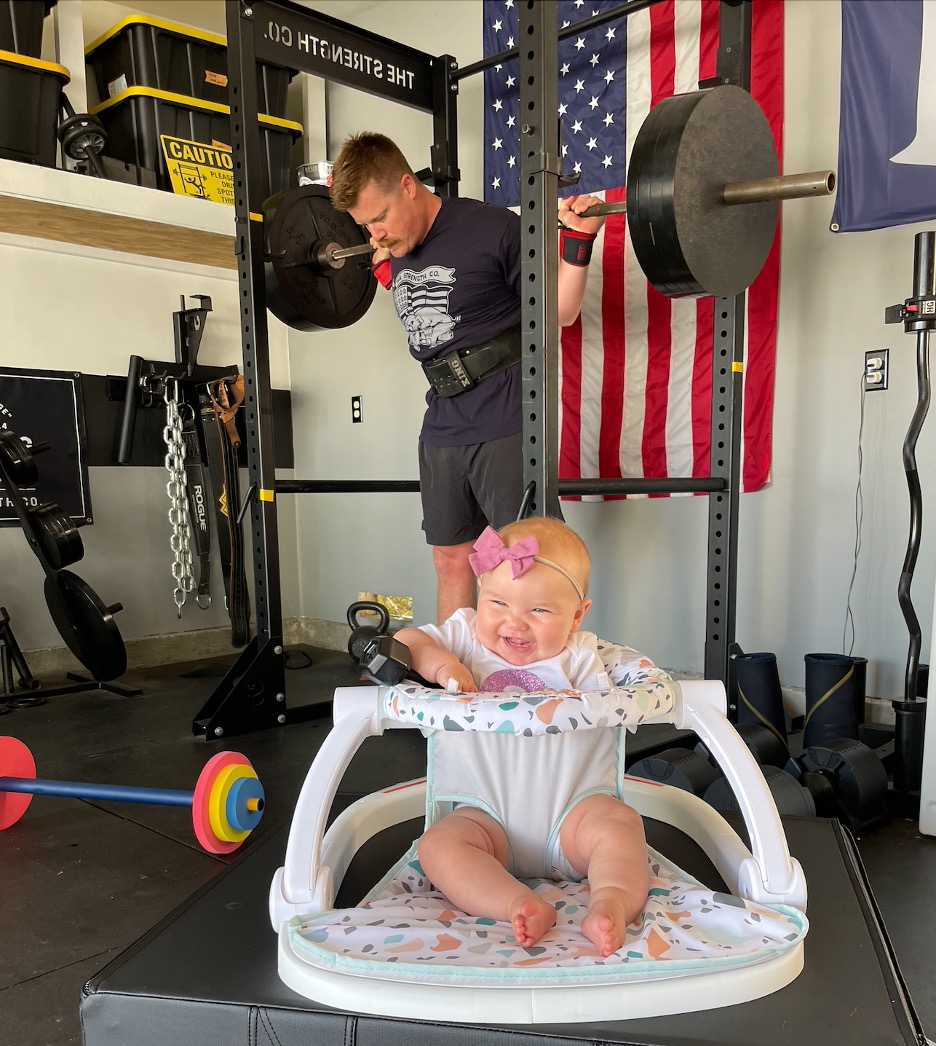 Charlie having some fun in the garage. Me too (kind of).
Charlie having some fun in the garage. Me too (kind of).
I have grown to view training as a basic need, like eating, sleeping and brushing my teeth. I view the time spent as an investment in my lifelong health. While it was very tempting to take a short break from lifting until I “settled into parent life”, I thought about my clients.
I have had the benefit of coaching a lot of great people, many of them parents. People with competitive careers, multiple children, and other responsibilities that take up a lot of their time. As their coach, I encourage them not to make excuses and find time to get their training in.
I reminded myself about the importance strength would play in my new role as a father and about how important my health would become in the years ahead. I decided to continue training despite the rocky few weeks and months in front of me.
So back to the changes that many experienced parents warned me about. My training continued but definitely changed quite a bit. I developed some basic adjustments to maintain my strength while also conserving time and energy for my new daughter and postpartum wife.
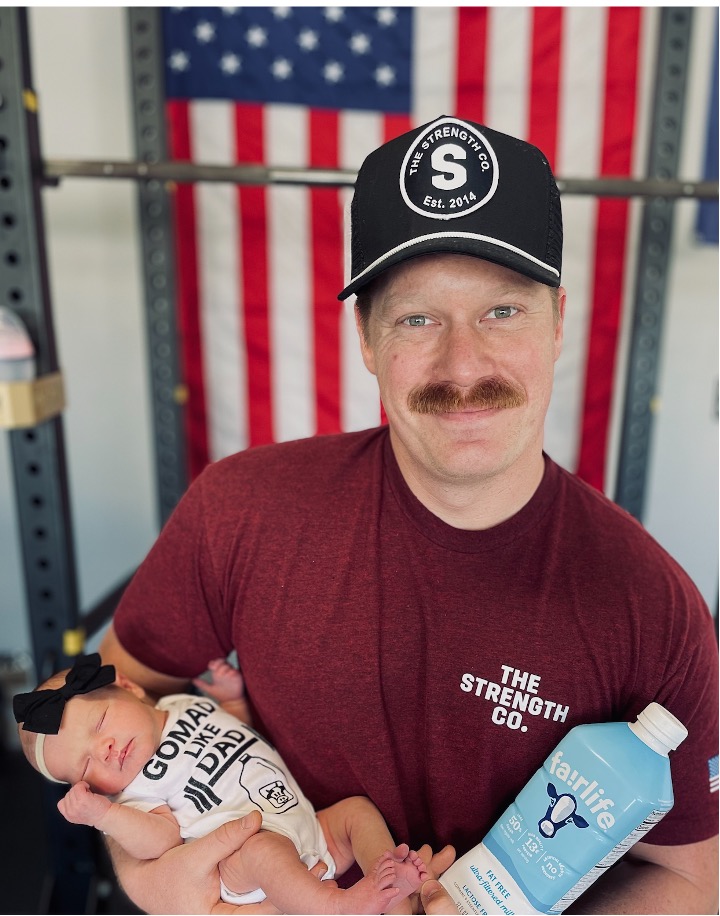 Charlie at 10 days old in our home gym.
Charlie at 10 days old in our home gym.
With six months as a parent now behind me, here are some tips that helped me continue my training:
Communicate with the Team
Well before the arrival of our daughter, during the “nesting” phase, my wife and I had multiple conversations about what we thought our lives would look like. We imagined new routines, alternate work times, planned recovery post delivery, and how we would fit lifting into our parental schedules.
Luckily, my wife is also a lifter, which helped her understand how much time I would need away from her and the baby. She knew how important it was to me to make plans to continue working out but I went ahead and reminded her anyway. I did not wait until we were thrown into postpartum life to come up with a general plan.
We planned out initial compromises and adjustments. My training sessions would no longer be over 2 hours. I would also need a consistent time to train but also still be around in case my wife needed help suddenly. Having a dedicated and consistent training time was important to me because I have found that it is strongly linked to compliance. Having a time set helps you honor your commitment to getting the work done.
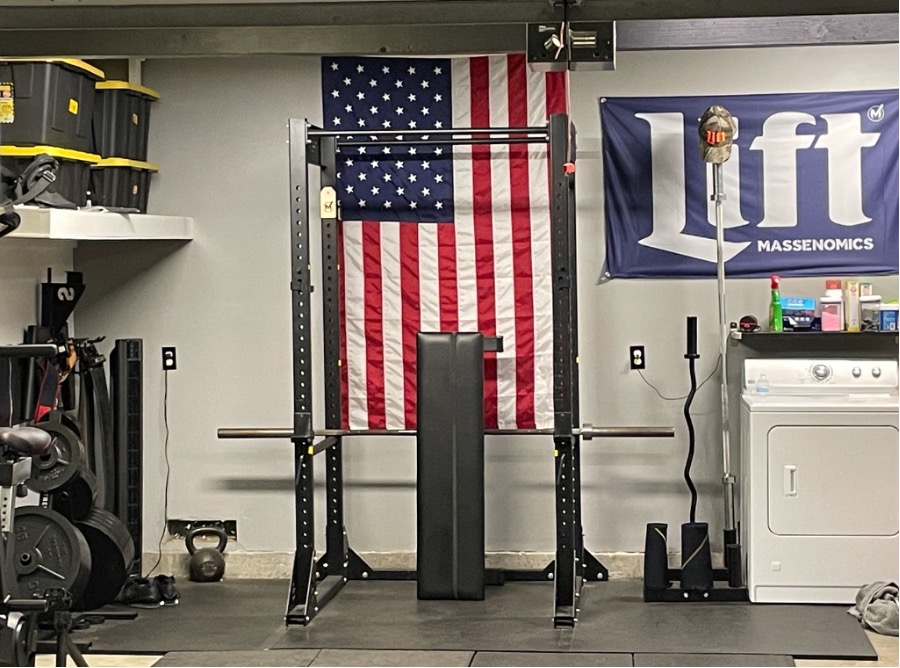 The power of a simple home gym. No commuting or waiting for equipment = more family time.
The power of a simple home gym. No commuting or waiting for equipment = more family time.
Something is always better than nothing
As a coach who programs other lifters, it is easy to fall into the trap of over-analyzing my own programming. After my daughter was born, it became clear that I needed to worry less about what was “optimal” and focus on what was possible for my current situation. Now was not the time to fall into an all or nothing mentality i.e: “Man I don’t have the time for my 3 sets of squats , bench, and deadlift, I might as well not lift today”.
I knew the first week would be rough so I made a promise to myself that I had to do something, anything – no matter what. My first “workout” as a parent was shortly after we arrived home from the hospital. My wife was recovering from a difficult delivery that ended in an emergency cesarean section.
While she was resting, I brought our (thankfully) sleeping daughter into the garage with me and knocked out 5 sets of chins-ups while I also folded some laundry. I was exhausted by the end of my workout.
This was not the optimal session with appropriate intensity and volume. But it was something. I got started, and it served as a signal to myself that I would continue the habit of training no matter how busy or tired I felt.
After another near sleepless night, I got up and took my daughter on our first walk together. That evening I got under the bar and quickly worked up to one tough set of 5 squats before ending my workout. Not optimal, not my best showing, but it was something. I did not just give up and go to sleep.
Keep it Short
Being a new parent messes with every conceivable recovery factor for lifting. Eating, sleeping, and the unquantifiable “life stress”. Before having a kid, I knew this in theory but not in practice. I had tried lifting while fasting but never lifting after a couple of nights without sleep.
That first week was exhausting, even with very light exercise. It took the wind right out of my sails in a way I had never felt before. I peeled myself off the nursery rocker and shuffled down to the garage. After a few warm-up sets, I felt like I had more energy than I did minutes before in my zombie-like state.
I also found that when the real work started my energy levels tanked, FAST. I had 1 maybe 2 quality work sets in me before a steep dropoff in performance under the bar on subsequent sets. My previous programming of 3 sessions a week of 90+ mins consisting of 3-4 exercises of multiple sets was not going to work due to time and effort constraints. I no longer had 90 mins on any day to devote to training but I could scrape together 30-45 mins on any given day.
Before kids, I was way too loose with my time in the gym. An hour of lifting could easily turn into 90 mins after responding to some texts, checking an email, and an extra water break during my session.
Since the baby, I have adopted a “running clock” mentality with my training. The accountability of a simple minute timer with a magnet placed on my rack has helped with keeping things efficient.
I soon learned that I had 35-45 minutes during a given naptime where I could get my lifting done. I would set the timer to countdown and race against the clock to complete what I had written in my training log.
This worked wonders for keeping my rest time to a minimum. I loaded plates as quickly as I could and removed the distractions around me. Sometimes I didn’t get my entire workout done before the timer chimed, which just left me more motivated to work more efficiently during the next session.
I switched training to a four day a week split with one lift per day to start. Beginning with just the basics: Squat, Bench, Deadlift, and Press. Sessions were short but focused and intense. Eventually I added more work to this routine by way of an additional lift and/or accessory movement into each day once I got into a scheduling rhythm after the first month.
 A simple timer is a great tool for time accountability between sets and for your overall training session.
A simple timer is a great tool for time accountability between sets and for your overall training session.
Intense but Conservative
In my postpartum training , I purposefully favored intensity (weight on the bar relative to the maximum weight I could lift for 1 rep ) over volume (total repetitions). In a nutshell, I worked harder rather than longer because I knew I couldn’t do both.
I did this to not only save time but also because this has been shown to help with muscle mass retention in situations where recovery is compromised i.e. a calorie deficit, lack of sleep or when taking on additional athletics endeavors .
With my 1 lift per day routine, I completed a handful of warm-up sets with very little rest ,eventually working up to and 1 difficult top set of 5-8 reps. The rep range existed to provide some flexibility based on how sleep deprived I was but I should be ending the set without much left in the tank.
Despite fatigue, it was easier to get psyched up for 1 hard set than even multiple sets across at a lighter load. 1 set to give it all I had. Take 10-20% off to hit a back off set leaving 1-2 reps in the tank and then done. While I had some failed reps during this process, I never intentionally stretched my sets to absolute failure.
I aimed to keep myself with about 1-2 reps in reserve. Meaning that if my life was at stake I could get 1 or 2 more reps at the end of my set. Figuring out where this is exactly is more easily achieved after a couple years of lifting experience.
I felt that the risk of pushing hard sets of 1-3 reps or taking sets to failure on the compound lifts was not worth the reward in an already depleted state. A potential nagging back tweak or tendonitis would ruin the whole point of training during this time.
Whether you’ve been training for years like me, or you are just getting started, the principles are the same. Work up to a heavy set of 5-8 reps and call it good. The key thing is finding a weight that is doable but “HARD”, you will need adequate stress in order to drive adaptation.
Multi-task
Time was my enemy as a new dad. One other trick to speed up my workouts was to pick up a second barbell for my home gym. While resting between working sets of one exercise, I began setting up and warming the next lift on my 2nd barbell. Eventually this evolved into “super-sets” when needed, where I trained two exercises back to back with little to no rest.
This worked best with pairing opposing muscle groups or a compound exercise with an assistance exercise. I.e squats paired with bench or overhead press paired with barbell rows.
This was tough at first. I had grown accustomed to sitting on my bench and scrolling through my phone until my rest period was over. Training one exercise while resting from another may not be “optimal” but remember, time is the enemy of a new parent. This helped me save a lot of time and a slight drop in performance was worth getting 2 exercises done quickly. After a while, my general conditioning adapted to these supersets anyway.
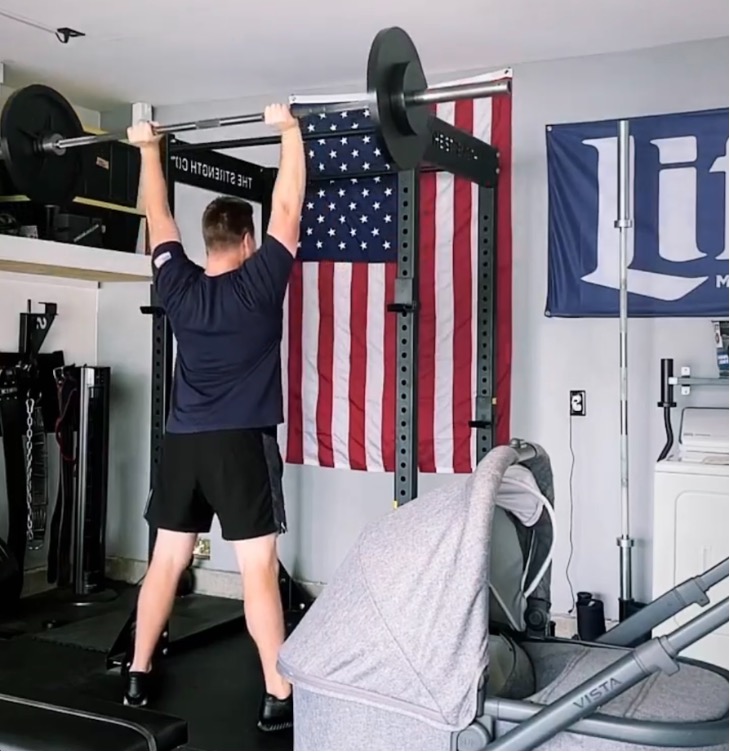 Typical session during month 2. Sleeping baby with the help of a washing machine in the background.
Typical session during month 2. Sleeping baby with the help of a washing machine in the background.
Include the Team (if possible)
Family time is as important as training. I also found that I could sometimes successfully blend the two. After the first month I began sneaking some “daddy-daughter lifting” in while she slept in her bassinet in my garage gym. With the washing machine providing background noise, I was able to get 30-45 mins of lifting in while she slept (excluding heavy deadlifts).
Now that she is old enough where she can entertain herself for a short time, she loves being in the garage while I lift. I am able to keep her in the bouncer and play with her between work sets.
My new training time is in the early morning, while everyone sleeps, which is the only time I can guarantee that it gets done. But I break routine on the weekends when the whole family can get a quick lift in together.
A pair of infant earmuffs to dampen the sound of heavy deadlifts. Add some crash pads if baby is napping.
The Silver Lining
While the first few months were tough, things did eventually get better. Our sleep has gotten more predictable and I have gradually added workloads more similar to my pre-baby training. These last 6 months have also given me a new respect and value for my time. I highly recommend a home gym for parents who can fit one in their house. I have a non-existent gym commute and am steps away from helping the wife and kid when I am needed.
Health and strength are as important as ever when you are promoted to “Dad Status”.
If you are a new or expecting dad with questions on how to adjust training in the short term, please reach out.
Special thanks to all the strong parents I coach who find the time to train.
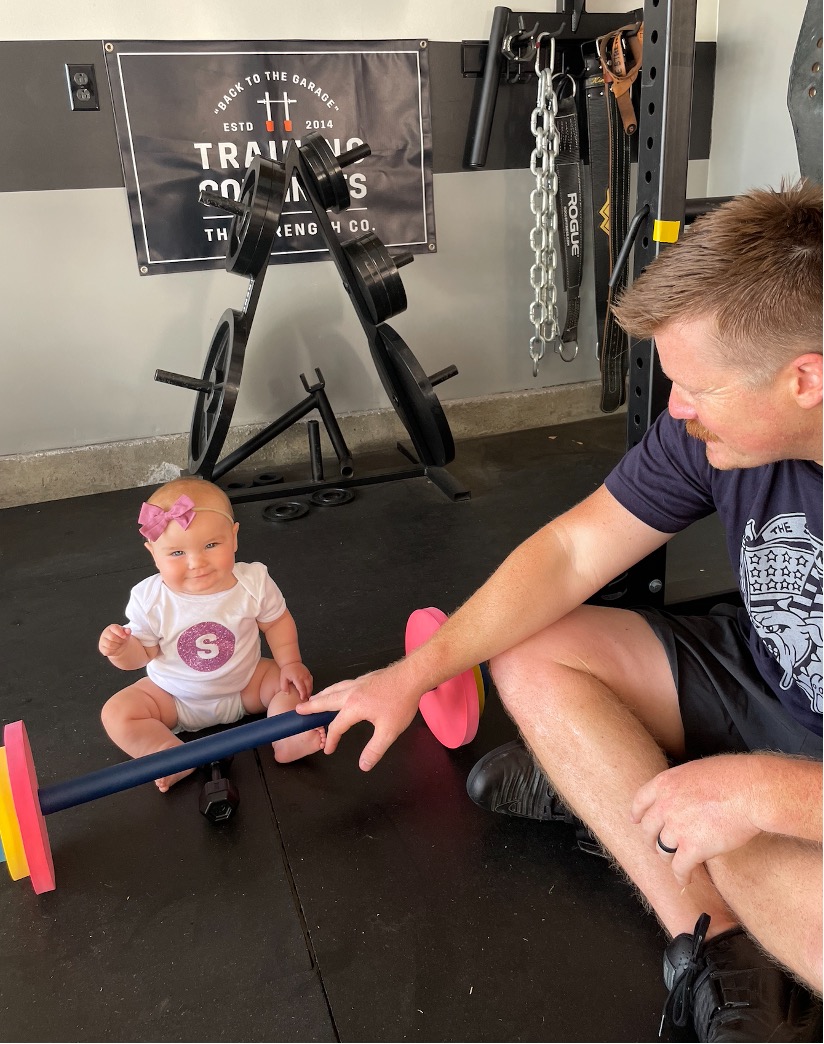
Charlie and I goofing around between sets

The real MVP of training as a new dad; an understanding and flexible wife.
